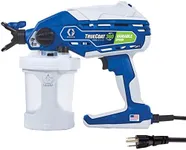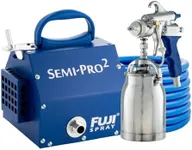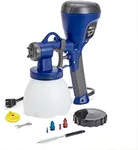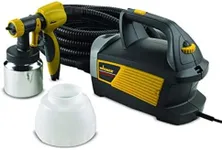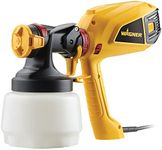Buying Guide for the Best Electric Paint Sprayers
Choosing the right electric paint sprayer can make your painting projects faster, easier, and give you a more professional finish. The key is to match the sprayer’s features to the type of work you plan to do, whether it’s painting walls, furniture, fences, or crafts. Understanding the main specifications will help you pick a sprayer that’s comfortable to use, delivers the right finish, and is easy to maintain.Type of SprayerElectric paint sprayers generally come in three main types: airless, HVLP (High Volume Low Pressure), and handheld. Airless sprayers are powerful and best for large surfaces like walls and fences, delivering paint quickly and evenly. HVLP sprayers are more precise, making them ideal for furniture or detailed work, as they produce less overspray. Handheld sprayers are compact and convenient for small projects or touch-ups. To choose the right type, think about the size and detail of your typical projects—large, flat areas benefit from airless, while smaller or more detailed work is better suited to HVLP or handheld models.
Flow Rate (Paint Output)Flow rate, often measured in gallons per minute (GPM) or liters per minute (LPM), tells you how much paint the sprayer can apply in a given time. Higher flow rates mean faster coverage, which is great for big jobs, but can be harder to control for fine work. Lower flow rates are slower but offer more precision. If you’re painting large surfaces, a higher flow rate saves time. For smaller or more detailed projects, a lower flow rate gives you better control and a smoother finish.
Nozzle/Tip SizeThe nozzle or tip size determines the width and thickness of the spray pattern. Larger tips are used for thicker paints and wider coverage, while smaller tips are for thinner materials and more detailed work. Most sprayers allow you to change tips for different jobs. If you plan to use a variety of paints (like stains, latex, or enamels), look for a sprayer with interchangeable tips and choose sizes that match your most common projects.
Adjustable Pressure ControlPressure control lets you adjust how forcefully the paint is sprayed. Higher pressure is useful for covering large areas quickly, while lower pressure is better for detail work and reducing overspray. Some sprayers have simple high/low settings, while others offer more precise adjustments. If you want versatility for different types of projects, look for a model with adjustable pressure so you can fine-tune the spray to your needs.
Ease of CleaningPaint sprayers need to be cleaned after each use to keep them working well. Some models have features like quick-release parts or self-cleaning modes that make this easier. If you plan to use your sprayer often or switch between different paints, choose a model that’s easy to take apart and clean, as this will save you time and frustration.
Weight and ErgonomicsThe weight and design of the sprayer affect how comfortable it is to use, especially for longer projects. Lighter, well-balanced sprayers are easier to handle and reduce fatigue. If you’ll be painting for extended periods or working overhead, look for a lightweight model with comfortable grips and controls that are easy to reach.
Paint Container SizeThe size of the paint container determines how often you’ll need to stop and refill. Larger containers are convenient for big jobs but can make the sprayer heavier. Smaller containers are lighter and easier to maneuver but require more frequent refills. Consider the size of your typical projects and how much weight you’re comfortable holding when choosing a container size.

